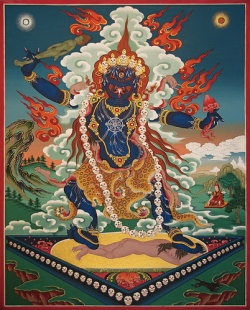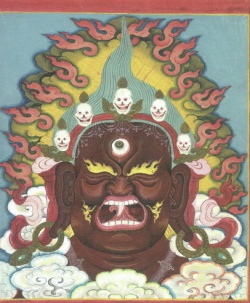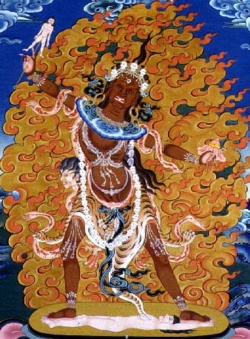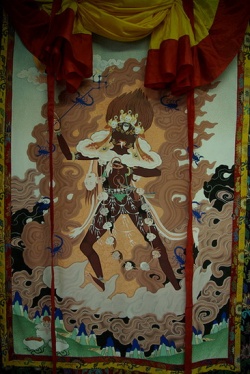Ekajati
Ekajaṭī or Ekajaṭā, (Sanskrit; Tibetan: ral chig ma.
English: One Braid of Hair), also known as Māhacīna-tārā, one of the 21 Taras, is one of the most powerful and fierce goddesses of Indo-Tibetan mythology.
According to Tibetan legends she is an acculturation of the Bön goddess of Heaven, whose right eye was pierced by the tantric master Padmasambhava so that she could much more effectively help him subjugate Tibetan demons.
Ekajati is also known as 'Blue Tara'.
She is generally considered one of the three principal Protectors of the Nyingma lineage, along with
Ekajaṭī
Rāhula and
Vajrasādhu or (Dorje Legpa).
Ekajati (Tibetan: Tsechikma or Ralchikma) Single plaited Mother
(Also known as Ngag Sungma, Mother Protectress of Mantra)
Ekajati is the supreme protectress of Ati Great Perfection Teaching, Dzogchen. She is a guardian of the tantric path and protects it from those who are unworthy.
She removes obstacles to the life and accomplishment of those who do practice on the Secret Mantra path. She is a guardian of mantras who keeps them from those who are unworthy of using them and ensures those who have been empowered to use them, do so for appropriate purposes.
She is wrathful and can assume a number of different forms and colors and the personal protector of the Dalai Lama. She is wrathful and can assume a number of different forms and colors. She can hold various implements and weapons.
She wears a wreath of severed heads, usually has one eye in the middle of her forehead, one fang and one breast. She is nearly naked and menacing as she stands amidst a mass of wisdom fire.
Ekajati is the highest of protectors. She guides those whom she protects upon the single path of unity of the innate Buddha nature. This is symbolized by the single open eye of wisdom upon her forehead, while her two eyes are sunken and dried, symbolizing the exhaustion of dualistic perception; by the single plait of hair that flows straight
upward, symbolizing the single unified path of the Ati Great Perfection; by her single tooth of the realization of the single nature of all. that pierces the aorta of dualistic demonic forces; and by her single breast that nurtures the pure practitioner upon the spiritual attainments of the single essence of ultimate truth.
Often she appears as liberator in the mandala of Green Tara.
Along with that her ascribed powers are removing the fear of enemies, spreading Joy and removing personal hindrances on the path to enlightenment.
Ekajati is the protector of secret mantras and "as the mother of the mothers of all the Buddhas," represents Absolute ultimate unity.
As such her own Mantra is also secret.
She is the most important protector of the Vajrayana teachings, especially the inner tantras and termas.
As the protector of Mantra she supports the practitioner in deciphering symbolic dakini codes and properly determines appropriate times and circumstances for revealing tantric teachings.
Because she completely realizes the texts and mantras under her care, she reminds the practitioner of their preciousness and secrecy.
The first Karmapa Düsum Khyenpa already meditated upon her in early childhood.
According to Chogyal Namkhai Norbu Rinpoche, she is the principal guardian of the Dzogchen teachings and is "a personification of the essentially non-dual nature of primordial energy."
Dzogchen is the most closely guarded teaching in Tibetan Buddhism, of which Ekajati is a main guardian as mentioned above. It is said that Sri Singha (Sanskrit:
Śrī Siṃha) himself entrusted the Nyingthik teachings to her care. To the great master Longchenpa, who initiated the dissemination of certain Dzogchen teachings, Ekajati offered uncharacteristically personal guidance.
In his thirty-second year, Ekajati appeared to Longchenpa, supervising every ritual detail of the Heart Essence of the Dakinis {Khandro Nyingthik} empowerment, insisting on the use of a peacock feather and removing unnecessary basin.
When Longchenpa performed the ritual, she nodded her head in approval but corrected his pronunciation.
When he recited the Mantra, Ekajati admonished him, saying, "Imitate me," and sang it in a strange, harmonious melody in the Dakini's Language.
Later she appeared at the gathering and joyously danced, proclaiming the approval of Guru Rinpoche (Padmasambhava) and the dakinis.
Visions of her are considered highly auspicious and to be treasured.
Origin
Ekajaṭī is found in both the Buddhist and Hindu pantheons; it is most often asserted that she originated in the Buddhist pantheon but some scholars argue this is not necessarily so. It is furthermore believed that Ekajaṭī originated in Tibet, and was introduced from there to Nalanda in the 7th century by (the tantric) Nagarjuna.
It appears that at least in some contexts she is treated as an emanation of Akshobhya.
Iconography
She is of a blue skin tone, with a high, red chignon ("she who has but one chignon" is another one of her titles). She has one head, three breast, two hands and a third eye. However, she can also be depicted with more Body parts; up to twelve heads and twenty four arms, with different tantric attributes (sword, kukuri, phurba, blue Lotus axe, vajra)
In another form her Hair is arranged in the same single bun with a turquoise forehead curl. This and her other features signify her blazing allegiance to nondualism.
Ekajati's single eye gazes into unceasing space, a single fang pierces through obstacles, a single breast "nurtures supreme practitioners as [her] children." She is naked, like awareness itself, except for a garment of white clouds and tiger skin around her waist.
The tiger skin is the realized Siddha's garb, which signifies fearless enlightenment.
She is ornamented with snakes and a garland of human heads. In some representations, she stands on a single leg. Her Body is dark in color, brown or deep blue.
She stands on a flaming mandala of triangular shape.
She is surrounded by a fearsome retinue of mamo demonesses who do her bidding in support of the secret teachings, and she emanates a retinue of one hundred ferocious iron she-wolves from her left hand.
For discouraged or lazy practitioners, she is committed to being "an arrow of awareness" to reawaken and refresh them.
For defiant or disrespectful practitioners, she is wrathful and threatening, committed to killing their egos and leading them to dharmakaya, or the ultimate realization itself. She holds in her right hand the eviscerated, dripping red Heart of those who have betrayed their Vajrayana vows.
In her most common form she holds an axe, drigug(cleaver) or khatvanga (tantric staff) and a skull cup in her hands. In her chignon is a picture of Akshobhya.
Her demeanor expresses determination. With her right foot she steps upon corpses, symbols of the ego. Her vajra laugh bares a split tongue or a forked tongue and a single tooth.
She is dressed in a skull necklace and with a tiger and a human skin. She is surrounded by flames representing Wisdom.
When Ekajati appears to yogins in hagiographies, she is especially wrathful. She speaks in sharp piercing shrieks, her eye boils, and she gnashes her fang. At times she appears twice human size, brandishing weapons and served by witches drenched in blood.
Ekajati (Tibetan: ral chig ma. English: One Braid of Hair), the principal protectress and guardian of the 'Revealed Treasure' tradition of the Nyingma School.
Black in colour and fearsome in appearance she has one central eye and one long white tooth, sharp, biting down over the lower lip. Her yellow hair flows upward like flames, twisted into a single braid.
The right arm is held upward with the hand in a wrathful gesture, the index finger pointed outward and emanating the form of a wolf, she brandishes a stick adorned with an impaled corpse.
The left hand upraised to the mouth holds a dark red human heart that almost conceals her single downward hanging breast.
Adorned with a tiara composed of five flower blossoms and three skulls, a scarf of smoke encircling the neck, the ears and limbs are decorated with earrings, bracelets, armlets and anklets while a flayed tiger skin is wrapped about the waist.
Completely surrounded by smoke and flames, with the right leg raised in a dancing posture she stands with the left foot pressing down on a prone figure lying atop a lotus blossom seat above a triangular throne decorated with nine human skulls.
"Arising from the mandala of suffocating black wind at a kalpa's end, Mistress of a host of activities and pristine awareness, Leader of the Mamos, Great Queen of the World;
Homage to the Lord of Mantra, Ekajati!"
(Nyingma liturgical verse).
Ekajati is a principal female protector in both the Nyingma (kama)(Old) and Sarma (New:
Sakya, Kagyu, Gelug) Schools of Tibetan Buddhism.
In the Nyingma School she is the chief protector for the 'Revealed Treasure' traditions and manifests in numerous forms, often appearing with only one eye and one tooth, sometimes with only one leg as in the red manifestation from the Longchen Nyintig tradition)] of Jigme Lingpa.
The different forms and descriptions of Ekajati are found in the various 'Revealed Treasure' texts of the Nyingma School.
In the Sarma Schools she is the mother of Shri Devi (Palden Lhamo) and has a more typical appearance with one face, three eyes, and two breasts, always in a semi-wrathful visage and with one braid of hair (Sanskrit: eka, one; jati, braid of hair).
She is found in the various Mahakala Tantra texts (anuttaryoga class) originating from India.
Ekajati is also found in the lower kriya tantra texts and more commonly in association with the important figure of Tara where she is often seen as an attendant figure standing on the left while the goddess Brikuti stands on the right side.
Troma Tantra
The 'Troma Tantra' or the 'Ngagsung Tromay Tantra' otherwise known as the 'Ekajaṭĭ Khros Ma'i rGyud' focuses on rites of the protector, Ekajati and is subsumed within the Vima Nyingtig.
bka' srung sngags srung ma - Ekajati [RY]
sngags srung ma - Ekajati [RY]
sngags srung ye ka dza ti' - Ekajati, Guardian of Mantrayana [RY] rdo rje spyan gcig - Ekajati [JV]
dpal sngags kyi srung ma - the Splendorous Protectress of Secret Mantra; Ekajati; [RY]
dpal e ka dza ti nag mo khros ma'i rgyud - Tantra of the Black Wrathful Shri Ekajati. This tantra describes how to protect the practitioner against harms inflicted by others [RY]
yang gsang bla na med pa'i sde - Innermost Unexcelled Cycle consists of seventeen tantras. There are eighteen when adding the Ngaksung Tröma Tantra which is focused on the protective rites of Ekajati.
According to the system of Padmakara, there are nineteen when including the Longsal Barwey Tantra, the Tantra of the Blazing Expanse of Luminosity [RY]
ral gcig ma - Ekajati, {rdzogs chen} protector [RY]
ral pa gcig ma - Ekajati [IW]
lha mo E ka dza ti - the goddess Ekajati [IW]



